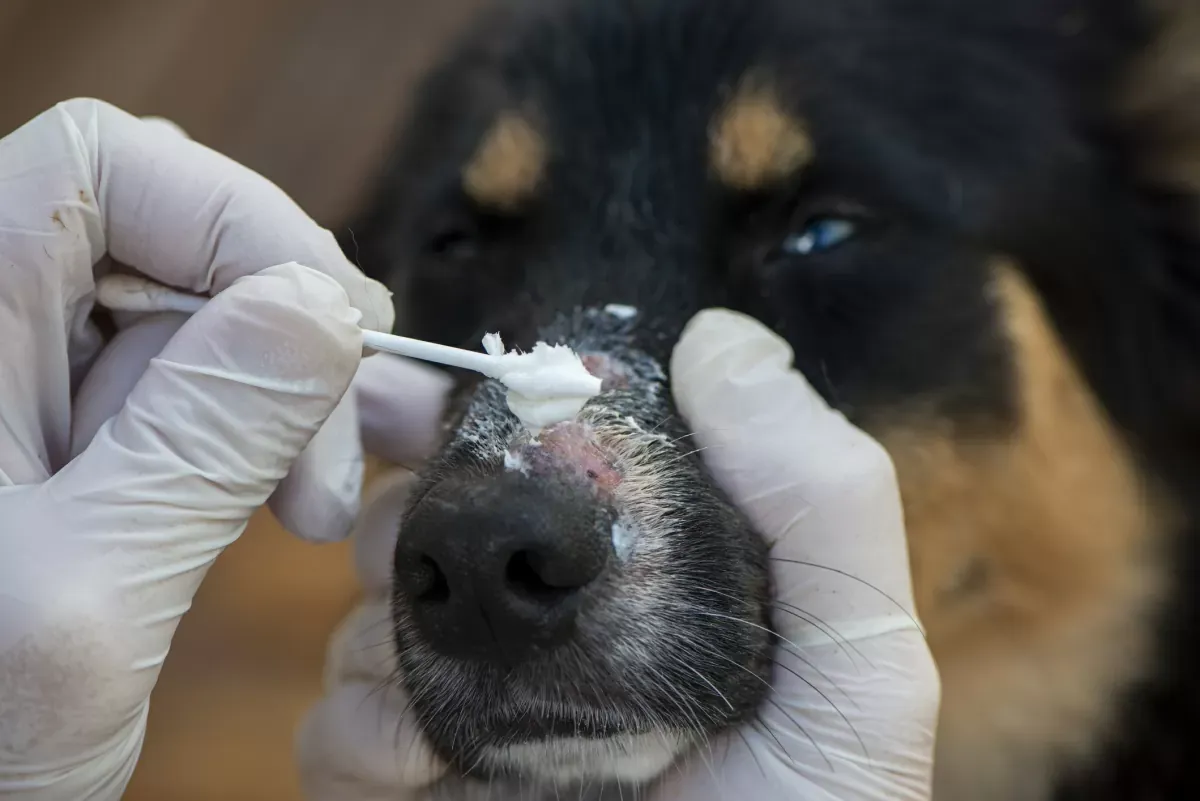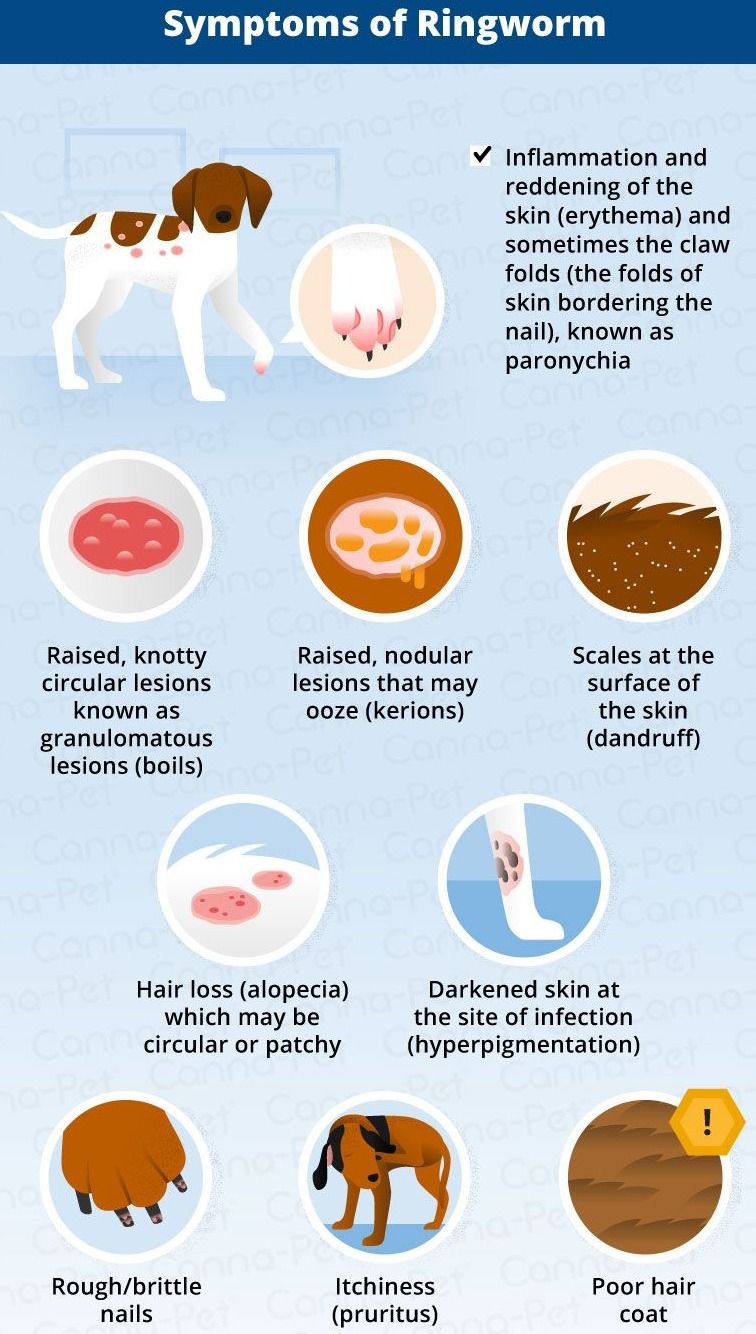Ringworm, contrary to its name, is not caused by worms but is a highly contagious fungal infection that affects the skin, scalp, and nails. It can be attributed to various fungi, such as dermatophytes and yeast, thriving in warm, moist environments. The appearance of ringworm varies depending on the affected area. If you're wondering what does ringworm look like:
On the scalp, it causes round patches of hair loss. On the body, it results in itchy, red, and scaly rashes. On the hands, feet, or groin, it resembles an athlete's foot or jock itch. Nails may become thick, discolored, and brittle.
Diagnosis typically involves a visual examination by a healthcare professional, sometimes complemented by tests like skin scrapings or fungal cultures for confirmation.
Treatment primarily consists of antifungal medications, either topical or oral, depending on the infection's severity and location. Prevention involves practicing good hygiene, avoiding personal item sharing, and minimizing close contact with infected individuals or animals.
Understanding the symptoms, causes, diagnosis, treatment, and prevention of ringworm is crucial in effectively managing and preventing the spread of this common fungal infection. If you're wondering what does ringworm looks like, it can present as described above based on the affected area.

What is Ringworm?
Ringworm is a common fungal infection caused by dermatophytes, thriving in warm, moist conditions. It spreads through direct contact or contaminated objects. Symptoms include circular, red, scaly rashes, often itchy. It can affect the scalp, body, groin, feet (athlete's foot), and nails.
Prevention involves good hygiene, avoiding item sharing, and using over-the-counter antifungal creams for mild cases. Severe cases may require oral antifungal medication prescribed by a healthcare professional. Prompt treatment and prevention are crucial to manage and stop the infection from spreading.
Is Ringworm a Worm?
Ringworm, despite its name, is not actually a worm. Rather, it is a fungal infection that affects the skin, scalp, or nails. This infection gets its name from the distinctive ring-shaped rash that often develops on the skin. It is important to note that ringworm is caused by a group of fungi called dermatophytes, not worms or insects. These fungi thrive in warm and moist environments like locker rooms, swimming pools, and shared towels or clothing.
When fungus penetrates the skin, it causes ringworm infection. To treat it, antifungal medications are essential, relieving symptoms like itching and redness. Good hygiene, avoiding item sharing, and keeping the affected area clean and dry are crucial for prevention. Remember, despite its name, ringworm is a fungal infection, not caused by worms. With proper treatment and hygiene, it can be effectively managed.
Causes of Ringworm
Ringworm, a prevalent fungal infection impacting the skin, hair, or nails, results from various causes that play a role in its development. Comprehending these underlying factors is crucial for thwarting the spread and reappearance of ringworm. Wondering what does ringworm look like? This knowledge is vital for effective prevention and management.
One significant cause of ringworm is exposure to certain types of fungi known as dermatophytes. These fungi thrive in warm and moist environments, making places like swimming pools, gyms, and locker rooms common breeding grounds for them.
Direct contact with infected individuals or contaminated surfaces is another way ringworm can easily be transmitted. Sharing personal items like towels, clothing, or sports equipment increases the risk of infection.
Individuals with weakened immune systems, such as those living with HIV/AIDS or diabetes, are more susceptible to ringworm infections. This is because their weakened immune response provides an opportunity for the fungus to thrive on their skin.
Poor hygiene practices can contribute to the spread of ringworm. Failing to regularly wash hands, not keeping the skin clean and dry, and wearing tight-fitting, non-breathable clothing all create an environment that is favorable for fungal growth.
Animals like cats, dogs, and farm animals can carry ringworm-causing fungi. Contact with these animals or their contaminated surroundings can lead to infection. Environmental factors like humidity and prolonged moisture exposure also increase the risk.
People with pre-existing skin conditions, like eczema or psoriasis, are more susceptible due to compromised skin barriers.
To prevent ringworm, practice good hygiene, avoid contact with infected individuals or animals, and keep your skin dry. Understanding these causes is crucial for prevention.
How is Ringworm Transmitted?
Ringworm is a fungal infection that can be easily transmitted from person to person or from animal to human. It is crucial to understand how ringworm is transmitted in order to prevent its spread.
1. Person-to-person transmission: Understanding how ringworm is transmitted is vital to prevent its spread from one person to another. Ringworm can be transmitted through direct skin-to-skin contact with an infected individual. This transmission can occur when engaging in activities like sharing personal items such as clothing, towels, or bedding. Additionally, ringworm can also be spread by touching surfaces or objects that have come into contact with the infection, such as gym equipment or shower floors.
2. Animal-to-human transmission: When comprehending how ringworm is transmitted, it is important to consider the transmission from animals to humans, particularly from cats and dogs. Pets that have ringworms may display patchy areas of hair loss with scaly or crusty skin. Close contact with an infected animal or touching their belongings, like bedding or grooming tools, can transfer the infection to humans.
3. Environmental transmission: Another mode of transmission to understand is environmental transmission. Ringworm can be transmitted indirectly through contaminated surfaces or objects, such as clothing, combs, or brushes. Fungal spores can survive on surfaces for an extended period of time. Therefore, it is crucial to maintain good hygiene and cleanliness in shared spaces to prevent the transmission of ringworm.
To halt the spread of ringworm and safeguard against transmission, it's vital to adhere to sound hygiene practices. This encompasses thorough handwashing with soap and water, refraining from item sharing, routine surface cleaning and disinfection, and the segregation of pets displaying potential signs of ringworm from other animals and humans. Swift treatment for ringworm infections and meticulous care and hygiene for affected pets are pivotal measures in preventing its dissemination. Curious about what does ringworm look like? Understanding this is integral for effective prevention.
Pro tip: If you suspect that you or your pet may have ringworm, it is best to consult a healthcare professional or veterinarian for an accurate diagnosis and appropriate treatment. Taking prompt action can help prevent further transmission and ensure a speedy recovery.
Symptoms of Ringworm
The symptoms of ringworm, also known as tinea, can vary depending on the location and severity of the infection. When it comes to identifying ringworm, there are several common symptoms to look out for:
- Skin rash: One of the primary indicators of ringworm is the development of a raised, red, and scaly rash on the affected area of the skin. The rash may appear circular or have a ring-like appearance, giving this condition its name "ringworm."
- Itching and discomfort: The rash caused by ringworm is often accompanied by intense itching and discomfort. As a result, individuals may scratch the affected area, which can further irritate the skin and contribute to the spread of the infection.
- Blisters or pustules: In certain cases, ringworms may cause the formation of small blisters or pustules filled with fluid. These may be present within the ring-shaped rash or on its edges.
- Dry and flaky skin: As the infection progresses, the affected skin may become dry, flaky, and scaly. This can cause the skin to appear cracked or peel.
- Hair loss: Apart from affecting the skin, ringworm can also target the scalp, resulting in patches of hair loss. These areas may be itchy and scaly, and the hair may break off close to the surface of the scalp.
Pro-tip: If you suspect you have symptoms of ringworm, it is important to seek medical attention for a proper diagnosis and treatment. Avoid self-diagnosis and over-the-counter treatments, as they may not effectively eliminate the infection. Furthermore, keep in mind that ringworm is highly contagious, so taking precautions to prevent its spread to others is essential.

What Does Ringworm Look Like on the Scalp?
Ringworm on the scalp is a common fungal infection that can manifest in various ways. Understanding its appearance can aid in early detection and timely treatment. Here is a detailed description of how ringworm may present on the scalp:
- Visual characteristics: Ringworm on the scalp typically begins as small, circular patches that can range in color from red to pink. These affected areas may exhibit scariness, raised borders, and mild itching.
- Hair loss: In certain cases, ringworms on the scalp can cause hair loss within the affected patches. This can lead to the development of bald spots or thinning of the hair in those particular areas.
- Resemblance to dandruff: Another distinguishing feature of scalp ringworm is the presence of dandruff-like flakes or scales on the surface of the patches. These flakes might appear white or yellowish in color.
- Scalp irritation and itchiness: Ringworm on the scalp often results in an itchy and inflamed scalp, which can be uncomfortable and irritating.
If you suspect that either you or someone you know might be experiencing ringworm on the scalp, seeking medical attention is crucial for accurate diagnosis and appropriate treatment. Topical and oral antifungal medications are commonly prescribed to treat this condition.
To prevent the spread of ringworm, it is advisable to refrain from sharing personal items like hats, combs, or brushes. Practicing good hygiene, such as regular handwashing and maintaining a clean, dry scalp, is also of utmost importance.
Remember, early detection and treatment are key to effectively managing ringworm. If you notice any symptoms or changes on your scalp, consult a healthcare professional for guidance and the right course of treatment.
What Does Ringworm Look Like on the Body?
Ringworm is a common fungal infection that can affect various body parts, like the scalp, hands, feet, groin, nails, and the body. On the body, it typically appears as a red, circular rash with raised edges. The center may be clear or scaly, while the outer edges are more red and raised. It's usually 1 to 4 inches in diameter and can be itchy. Avoid scratching to prevent complications.
If you see such a rash, seek medical advice for a proper diagnosis. A healthcare professional can visually examine it and may do tests to confirm ringworm. To prevent its spread and aid healing, practice good hygiene, keep the area clean and dry, avoid sharing personal items, and use prescribed antifungal treatments.
Untreated body ringworm can spread and cause discomfort, so prompt professional consultation is advisable for accurate diagnosis and treatment.
True story: Sarah noticed a red, itchy rash on her body that had a circular shape with raised edges. Concerned, she visited her dermatologist, who confirmed that it was indeed ringworm. Sarah followed the prescribed treatment plan, which included antifungal cream and keeping the affected area clean and dry. Within a few weeks, the rash gradually disappeared, and Sarah was relieved. She learned the importance of seeking medical advice for skin conditions and how early treatment can lead to a faster recovery.
What Does Ringworm Look Like on the Hands?
Ringworm is a common skin infection caused by a fungus. It can affect various parts of the body, including the hands. So, what does ringworm look like on the hands? When it comes to ringworms on the hands, it typically manifests as a red or pink rash in the shape of a ring. This rash exhibits a clear or scaly center, while its outer edges are raised and bumpy.
Apart from its distinctive appearance, the rash can be itchy and painful. Such itchiness provokes discomfort and an intense urge to scratch the affected area. Nonetheless, scratching can exacerbate the irritation and lead to the spread of the infection to other areas.
Additionally, ringworms on the hands may cause the affected skin to scale, peel, or become dry. Consequently, one may notice rough or flaky patches on their hands, giving the skin an altered texture.
In certain cases, ringworms on the hands can manifest as tiny blisters filled with fluid. These blisters can be painful and further contribute to the overall discomfort experienced by the individual.
As time progresses, the skin affected by ringworm on the hands may develop cracks or fissures, adding to the discomfort. These cracks and fissures not only worsen the condition but also increase the risk of secondary bacterial infections.
If you happen to observe any of these symptoms on your hands or suspect you have ringworm, it is crucial to seek medical advice promptly. This will ensure proper diagnosis and treatment, ultimately alleviating the symptoms, preventing the infection from spreading, and facilitating faster healing.
What Does Ringworm Look Like on the Feet?
Ringworms on the feet often present as red, scaly patches on the skin. These patches have a circular shape and may start as small bumps, eventually expanding into larger, round patches. One distinctive feature of ringworm on the feet is the clearing in the center, giving it a ring-like appearance. In some cases, blistering and cracking of the skin may occur, causing pain and discomfort while walking or wearing shoes. Furthermore, as the infection progresses, the affected skin on the feet may peel and become scaly, resulting in a dry and flaky appearance. It is important to note that the severity of these symptoms can vary from person to person. If you suspect you have ringworm on your feet, it is advisable to consult a healthcare professional for an accurate diagnosis and appropriate treatment. Additionally, maintaining good hygiene practices, such as regular foot washing and keeping them dry, is crucial in preventing the spread of ringworm and other fungal infections.
What Does Ringworm Look Like on the Groin?
Ringworm on the groin, also known as tinea cruris, presents as a rash that is typically red and itchy. The appearance of the affected area may be circular or ring-shaped, with a raised, scaly border. In some cases, the center of the rash may have a slightly lighter color or appear more normal. The rash can spread and may become more irritated due to scratching or friction. It's worth noting that the appearance of the rash can vary from person to person, and it may not always have a classic ring shape.
To accurately diagnose ringworm in the groin, it is necessary for a healthcare professional to examine the rash and collect a sample of the skin for testing. This step helps confirm the presence of the fungus responsible for causing ringworm.
The treatment for ringworm in the groin typically involves the prescription of antifungal medications. These medications are commonly available in the form of creams, ointments, or oral tablets. It's important to adhere to the prescribed treatment regimen and continue the treatment for the recommended duration, even if the rash seems to be improving.
To prevent the spread of ringworm in the groin, it is crucial to practice good hygiene. This includes keeping the affected area clean and dry, refraining from sharing personal items like towels or clothing and wearing loose-fitting clothing made from breathable fabrics. Additionally, scratching the rash should be avoided to prevent further irritation and spread of the fungus.

What Does Ringworm Look Like on the Nails?
- Ringworms on the nails, also known as onychomycosis, can cause changes in the appearance and texture of the nails.
- The nails may become thickened, brittle, and yellowish in color.
- There may be white or yellow patches or spots on the surface of the nails.
- The nails may become rough or crumbly.
- In severe cases, the nails may become distorted, lifting from the nail bed, and may even separate from the nail bed.
- Ringworm infection can also lead to pain and discomfort in the affected nails.
To identify ringworms on the nails, it is important to look for these specific symptoms. If you notice any of these changes in your nails, it is recommended to consult a healthcare professional for diagnosis and treatment options.
If you suspect ringworm on your nails, it is crucial to take preventive measures to avoid spreading the infection to others. Avoid sharing personal items such as nail clippers or files, and keep your nails clean and dry. It is also advisable to avoid walking barefoot in public areas such as locker rooms or swimming pool areas.
With early diagnosis and appropriate treatment, ringworms on the nails can be effectively treated. Your healthcare provider may recommend antifungal medications, topical treatments, or in severe cases, oral medications. Following their instructions and maintaining good nail hygiene can help in the successful management of ringworms on the nails.
Diagnosis of Ringworm
Ringworm, a fungal infection that affects the skin, requires a careful diagnosis to determine the appropriate course of action. There are several important steps involved in the diagnosis of ringworm.
Firstly, a healthcare professional will visually examine the affected area. They will search for key indicators such as a circular rash with raised edges and clear skin in the center. This visual examination is crucial when diagnosing ringworm.
Secondly, a Wood's lamp examination may be employed. This special lamp emits ultraviolet light, which can reveal certain types of fungi responsible for causing ringworm. However, it is important to note that not all types of ringworm show fluorescence under a Wood's lamp.
In some cases, a skin scraping is necessary to confirm the diagnosis. Here, the healthcare professional gently scrapes the affected area and studies the obtained sample under a microscope. This process allows them to identify the presence of fungal elements that cause ringworm.
Furthermore, a fungal culture might be conducted. This involves collecting a sample from the affected area and placing it in an environment that fosters fungal growth. By doing so, the specific type of fungus causing the infection can be identified.
Lastly, healthcare professionals must consider differential diagnosis to rule out other conditions that manifest similar symptoms to ringworm. Conditions like eczema, psoriasis, and other fungal infections can mimic the appearance of ringworm. Through a careful evaluation of all possibilities, a proper diagnosis can be made.
By following these diagnostic steps, healthcare professionals can accurately identify and diagnose ringworm, allowing for appropriate treatment to alleviate the infection.
Can Ringworm Be Diagnosed at Home?
Ringworm is a common fungal infection that affects the skin, scalp, nails, and other parts of the body. While it is generally recommended to seek medical advice for an accurate diagnosis, there are instances where ringworm can be diagnosed at home.
Can ringworm be diagnosed at home? One way to determine if you have ringworm is by examining the affected area. Ringworm often appears as a red, circular rash with a raised border. The center of the rash may be clear or scaly. It can be itchy and may cause discomfort. If you notice these symptoms and have a history of exposure to ringworm or contact with an infected individual, there is a possibility that it could be ringworm.
While a Woods lamp can occasionally aid in identifying ringworm at home by causing specific fungal infections to fluoresce, it's not consistently definitive. Self-diagnosis might lack accuracy. It's advisable to consult a healthcare professional for confirmation through tests like skin scrapings or cultures. While it's possible to diagnose ringworm based on symptoms, consulting a healthcare professional is the best approach for a precise diagnosis and treatment. Wondering what does ringworm look like? Consulting a healthcare professional ensures accuracy.
What Tests Are Done to Diagnose Ringworm?
To diagnose ringworm, healthcare professionals perform several tests. The first is a visual examination, where they inspect the affected area for characteristic signs such as red, scaly patches in circular shapes. To detect fluorescent fungi, they may also use a specialized light called a Wood's lamp.
The second test is skin scraping. For this, a small sample of the affected skin surface is collected and examined under a microscope to check for fungal elements.
In some cases, a fungal culture is performed to confirm the diagnosis and identify the specific type of fungus causing the infection. This involves placing a sample of the affected skin or hair on a nutrient medium in a laboratory and observing it over time for the growth of the fungus.
If a healthcare professional suspects a more severe or atypical form of ringworm, a biopsy may be conducted. During a biopsy, a small sample of skin is taken for further examination under a microscope to determine the exact cause of the symptoms.
It is important to seek medical attention if you suspect you have ringworm. Self-diagnosis based on appearance alone is not reliable, as other skin conditions can mimic ringworm. A correct diagnosis will ensure appropriate treatment and prevent the spread of infection.

Treatment and Prevention of Ringworm
- For treating ringworm, antifungal medications are key. Use them topically as creams, ointments, or sprays. Severe cases may need oral medication. Follow the prescribed treatment and maintain it for the recommended duration for complete recovery. Keeping the affected area clean and dry can speed up healing.
- To prevent ringworm, maintain good personal hygiene, avoid sharing items like clothing and towels, keep skin clean and dry, wear clean and breathable clothing, and steer clear of infected individuals or contaminated surfaces. Regularly disinfecting communal areas like locker rooms and gyms helps prevent its spread.
Fact: Studies have revealed that regularly washing hands with soap and water can greatly reduce the risk of contracting and spreading ringworm.
What Are the Available Medications for Ringworm?
- What Are the Available Medications for Ringworm? Topical antifungal creams, containing clotrimazole, miconazole, terbinafine, or ketoconazole, reduce the fungus and ease symptoms. Apply directly to the affected area multiple times daily for several weeks, adjusting for infection severity.
- Antifungal ointments, like creams, treat ringworm. They're thicker and stay put in areas like the scalp or feet. Apply directly, and use it for a few weeks.
- Available ringworm medications include oral antifungal drugs like terbinafine or fluconazole, prescribed by healthcare professionals for severe or widespread infections. These meds work internally to eliminate the fungus, usually taken for several weeks with a prescription.
- What Are the Available Medications for Ringworm? For ringworm fungus-causing on the scalp, antifungal shampoos containing substances like ketoconazole or selenium sulfide can be used. These shampoos are applied to the scalp and left on for a few minutes before rinsing. They are typically used two to three times a week for several weeks.
- Not all medications suit everyone due to allergies or medical conditions, so consult a healthcare professional before starting any treatment.
To prevent ringworm spread and recurrence, keep the affected area clean and dry, avoid sharing personal items, and practice good hygiene. Check pets for signs of ringworm and seek veterinary care if needed.
Medications for ringworms vary by severity and location. Topical creams are common, while oral meds are for severe cases. Follow the recommended treatment and consult a healthcare pro for guidance.

Can Ringworm Be Treated Naturally?
When it comes to treating ringworm, natural remedies can be considered as alternatives to conventional medications. Can ringworm be treated naturally? Here are some ways in which ringworm can be treated naturally:
- Essential oils: Certain essential oils such as tea tree oil, lavender oil, and oregano oil have antifungal properties that can help in treating ringworm. These oils can be diluted with a carrier oil and applied directly to the affected area.
- Garlic: Garlic possesses antifungal properties and can be used to treat ringworm naturally. Crushed garlic can be applied directly to the affected area or mixed with olive oil to create a paste.
- Apple cider vinegar: Apple cider vinegar has natural antifungal properties. It can be diluted with water and applied to the affected area using a cotton ball. It is important to note that apple cider vinegar may cause a burning sensation, so it should be used with caution.
- Aloe vera: Aloe vera gel has soothing properties that can help reduce itching and inflammation caused by ringworm. Applying fresh aloe vera gel directly to the affected area can promote healing.
- Coconut oil: Coconut oil contains antifungal properties that can help eliminate the fungus-causing Be ringworm. Applying coconut oil to the affected area can help soothe the skin and prevent further spread of the infection.
While these natural remedies can provide relief from ringworm symptoms, it is important to consult a healthcare professional for an accurate diagnosis and to determine the best course of treatment. Natural remedies may not be effective for severe or resistant cases of ringworm.
How Can Ringworm Beringworms Prevent?
To prevent ringworm, it is important to take certain measures to minimize the risk of infection. Here are some steps you can take to prevent ringworm:
- Maintain good personal hygiene by washing your hands regularly with soap and water. This helps to eliminate any potential sources of infection.
- Avoid sharing personal items such as towels, clothing, or hairbrushes with someone who has ringworm. This helps to prevent the spread of the infection.
- Keep your skin clean and dry, as ringworm thrives in warm and moist environments. After bathing or swimming, make sure to thoroughly dry your skin, especially in areas prone to sweating.
- Wear loose-fitting clothing made of breathable fabrics, such as cotton. This allows air to circulate and helps to keep your skin dry.
- Avoid walking barefoot in public places, such as locker rooms, gyms, or swimming pools. Instead, wear sandals or flip-flops to protect your feet from coming into contact with fungal spores.
- If you have pets, regularly check them for signs of ringworm. Promptly take them to a veterinarian if you suspect they are infected, as they can transmit the infection to humans.
- Take extra precautions if you participate in contact sports, such as wrestling or football, where close physical contact is common. Make sure to shower immediately after activities and wash your clothes and equipment regularly.
By following these preventive measures, you can reduce the risk of contracting ringworm and keep yourself and those around you safe and healthy.
Is Ringworm Contagious?
Ringworm is a highly contagious fungal infection that easily spreads through direct contact with an infected person or animal. It can also be transmitted through contact with contaminated surfaces like clothing, towels, and bedding. Understanding the contagious nature of ringworm is crucial for preventing its spread.
To prevent the transmission of ringworm, it is important to avoid sharing personal items such as combs, hats, or brushes with individuals who have the infection. In addition, maintaining good hygiene practices and regularly washing hands can minimize the risk of contracting the infection. Cleaning and disinfecting common areas, especially if someone in the household has ringworm, is also essential for preventing the fungus from spreading to others.
Let me share a true story to highlight the contagiousness of ringworm. Sarah, a young girl who enjoyed playing with her neighbor's pet cat, discovered a red, scaly patch on her arm one day. Recognizing it as ringworm, her mother promptly took her to the doctor, who confirmed the diagnosis and explained the high contagion rate of the infection. It was determined that Sarah likely contracted the infection from the cat's fur. In light of this, Sarah's mother contacted their neighbor to inform them of the situation and advised them to seek treatment for their cat. Sarah was prescribed antifungal medication, and her mother diligently cleaned and disinfected their home to prevent the spread of ringworm to other family members. Thankfully, with proper treatment and precautions, Sarah's ringworm infection cleared up, and the outbreak was successfully contained. This story serves as a reminder of the contagiousness of ringworm and the importance of taking necessary measures to prevent its spread.
In conclusion, understanding "What Does Ringworm Look Like" is crucial for early detection and effective treatment. Consulting a healthcare professional provides accurate diagnosis and guidance for managing this common fungal infection.
Frequently Asked Questions
What does ringworm look like on the skin?
Ringworm appears as a red ring of small blisters or scaly skin that spreads outward in a circular pattern as the infection progresses.
Can ringworm affect different parts of the body?
Yes, ringworms can appear on different parts of the body, such as the skin, scalp, feet, groin, beard, face, hands, and nails.
Is ringworm caused by worms?
No, ringworm is not caused by worms. It is caused by fungi called dermatophytes that can live off the dead tissues of the skin, hair, and nails.
How is ringworm transmitted?
Ringworm is highly contagious and can be spread through direct contact with an infected person, animals, or contaminated surfaces like towels and bedding.
How is ringworm diagnosed?
Diagnosing ringworm involves examining the affected area and taking a sample for laboratory testing to confirm the presence of the fungi causing the infection.
What are the treatment options for ringworm?
Treatment options for ringworm include antifungal creams, ointments, and oral medications. It is important to complete the prescribed duration of treatment to ensure complete eradication of the infection.






